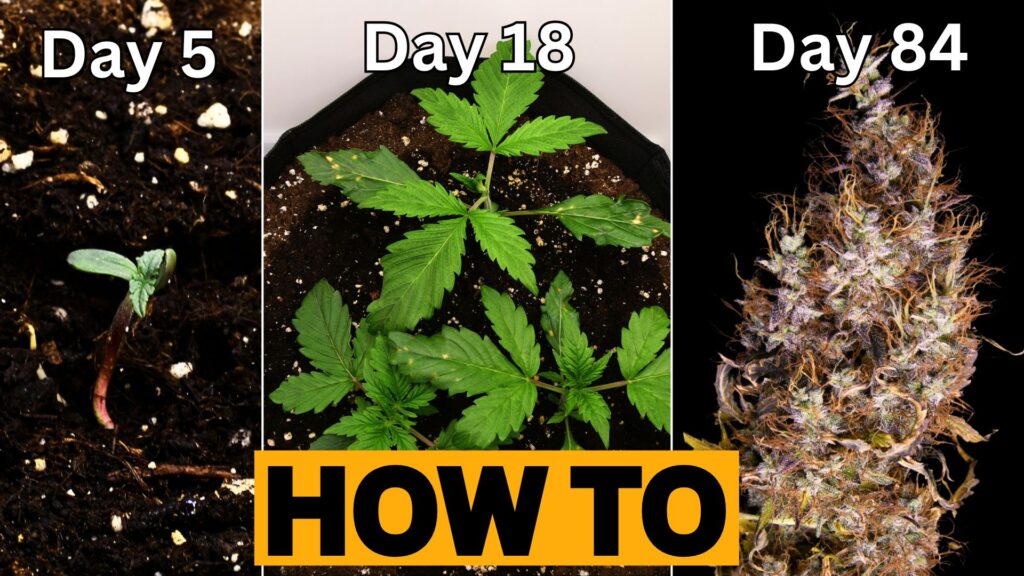Date: 26.03.2025

Cultivating autoflower cannabis is a rewarding experience, especially with the right setup. These plants are fast-growing, resilient, and ideal for beginners and experienced growers alike. This guide covers everything from choosing the right soil and nutrients to optimizing lighting, watering, and training techniques for maximum yield.
The Best Soil for Autoflowers
Autoflowers thrive in light, well-aerated soil that supports rapid root development. A good mix includes:
- 50% High-Quality Organic Soil – Provides essential nutrients.
- 30% Perlite – Enhances drainage and oxygenation.
- 20% Coco Coir – Retains moisture while preventing compaction.
Avoid using soil that is too dense or rich in nutrients, as autoflowers are sensitive to overfeeding. But if you are lazy like me sometimese: Just go to a good garden shop and get some airy and nutrient rich soil!
Optimal Lighting for Growth
Unlike photoperiod cannabis, autoflowers don’t require a strict light schedule, but proper lighting still significantly affects their yield. Recommended light cycles:
- Seedlings (0–14 days): 24 hours for rapid early growth, but make sure to not use the full light intensity – otherwise it might hurt the plants
- Vegetative Stage (15–40 days): 20/4 or 18/6 to balance growth and energy use. Increase the light intensity step by step (over days) until you are at 100%
- Flowering Stage (40+ days): 18/6 to maintain consistent bud production.
A full-spectrum LED grow light positioned 30–40 cm above the plants ensures even light distribution without burning the leaves.
Temperature & Humidity Control
Maintaining stable environmental conditions is essential for healthy growth:
- Seedlings: 22–26°C, 60–70% humidity.
- Vegetative Stage: 22–28°C, 50–60% humidity.
- Flowering Stage: 18–26°C, 40–50% humidity.
Using an exhaust fan and oscillating fan helps maintain airflow and prevent heat buildup or mold growth. If you have issues with humidity I can highly recommend you to use a humidifer (I’d like to use once from Levoit like this: https://amzn.to/3DTI2fC)!
Watering Techniques
Overwatering is a common mistake when growing autoflowers. A simple watering guide:
- Seedlings: Light misting every 1–2 days.
- Vegetative Stage: Water when the top 2–3 cm of soil is dry.
- Flowering Stage: More frequent watering, but avoid over-saturation.
Keeping the pH between 6.0 and 6.5 ensures efficient nutrient uptake and prevents deficiencies. If you live in regions where the water is very hard it might even make sense to filter it beforehand!
Fertilizing Autoflowers
Autoflowers are light feeders, so nutrients should be applied carefully:
- Vegetative Stage:
- Use a nitrogen-rich fertilizer to promote leafy growth.
- Start with half the recommended dose and increase as needed.
- Flowering Stage:
- Switch to a phosphorus and potassium-rich bloom fertilizer.
- Reduce nitrogen intake to encourage bud development.
Signs of overfeeding include dark green leaves and nutrient burn, while pale leaves may indicate a deficiency. I’d like to use fertilizer like this: https://amzn.to/4l01HLs
Training Techniques for Maximum Yield
Since autoflowers have a short growth cycle, low-stress training (LST) is the best approach to improve yield without stunting growth.
1. Bending & Tying Down (LST)
- Gently bend the main stem and tie it down with soft wire or garden ties.
- This technique promotes an even canopy and allows lower bud sites to receive more light.
- You can even use this later on to make sure you plants are on the same height (this makes it easier to adjust the light)
2. Lollipopping for Bud Focus
- Around mid-flowering, remove lower leaves and small branches that receive little light.
- This directs energy to the top colas, producing larger, denser buds.
- Good tutorial: https://www.royalqueenseeds.com/blog-how-to-dramatically-boost-yields-with-cannabis-lollipopping-n1314
Harvesting, Drying & Curing
By day 70–80, trichomes should appear milky-white, indicating peak harvest time.
- Drying: Hang buds in a dark, well-ventilated space at 18–22°C and 50% humidity for 7–10 days.
- Curing: Store dried buds in glass jars with 62% humidity packs, opening daily for 2 weeks to enhance flavor and potency.
Common Growing Issues & Solutions
- Yellowing leaves early in growth: Likely nitrogen deficiency.
- Brown spots on leaves: Calcium or magnesium deficiency.
- White powdery residue: Potential mildew—improve airflow.
- Drooping leaves: Caused by overwatering or underwatering.
Final Thoughts
Do you prefer watching my growth timelapse/tutorial? Here you go:
Growing autoflower cannabis is a straightforward process when the right conditions are maintained. With proper soil, lighting, and training techniques, even beginners can achieve excellent yields. Experimenting with different strains and refining techniques over time will lead to even better results. Happy growing! 🌱